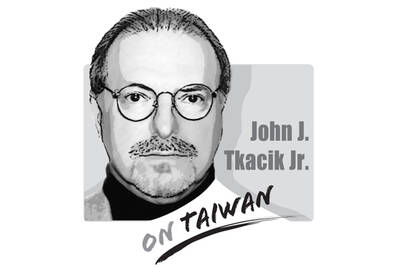The verdict issued by the Taipei High Administrative Court on Friday that deprived the Far Eastern Electronic Toll Collection Co of its priority status as installer of the nation's first electronic toll-collection (ETC) system has proved an embarrassment for the government and the contractor, and raised more uncertainties for motorists. The ruling has hurt the government's credibility and casts uncertainty over the future use of the build-operate-transfer (BOT) model.
Unlike the current toll system, where motorists have to brake to a stop at the toll plaza and hand over a ticket or cash to a tolltaker, the high-tech ETC system allows motorists to roll past a toll booth while a roadside sensor identifies the vehicle and performs an electronic transaction on a pre-paid account.
This type of system has become increasingly popular in other countries in recent years, and is worthy of support if it can increase toll lane capacity and reduce motorists' waiting times.
But the ETC system was plagued with problems even before the NT$10 billion (US$307.7 million) BOT project was awarded in February 2004 to Far Eastern, a joint venture headed by Far Eastone Telecommunications Co and Austria's Efkon AG.
Because of the business opportunities the project was thought likely to generate, more than NT$300 billion according to some estimates, there was much debate over which technology would perform best -- microwave or infrared technology. Far Eastern chose infrared. However, the whole project subsequently became mired in allegations of corruption -- including charges that standards were lowered to suit the chosen contractor -- and judicial authorities are still investigating several legislators, Ministry of Transportation and Communications officials and representatives of ETC providers.
When Far Eastern launched the service earlier this month more chaos ensued. Consumers complained that the system's vehicle on-board units (OBUs) were too expensive and threatened to boycott the service.
During the Lunar New Year holiday, the system almost paralyzed heavy holiday traffic because few vehicles were equipped with OBUs and therefore able to use the exclusive lanes set aside for the service.
The government has said it is considering appealing Friday's ruling to the Supreme Administrative Court. If it loses the appeal, it may either reopen the tender or abandon the BOT model and run the system itself.
The government's pledge to safeguard the rights of motorists regardless of the result of the appeal is welcome news, but at the same time, it's potential move to take over the system and use taxpayers' money to run the project is a concern.
In the face of the government's persistent budget deficits, how is it that it suddenly believes there may be sufficient funds to run the project, when it originally adopted the BOT model to save taxpayers' money?
A second concern is that the government has said it may buy back Far Eastern's toll facilities if its appeal fails. However, it's not clear that Far Eastern's infrared technology is the best solution. It is only suitable for single-lane toll collection, not the multi-lane free-flow toll collection that microwave technology can serve.
The government has been trying to minimize the damage in the wake of Friday's ruling. At the least, it should learn the lesson that it needs to increase the transparency of screening processes for future BOT projects.
Unfortunately, taxpayers are the ultimate losers in this project. It remains to be seen whether a more reasonable ETC system can be devised out of the ruins of the current mess.
A Chinese diplomat’s violent threat against Japanese Prime Minister Sanae Takaichi following her remarks on defending Taiwan marks a dangerous escalation in East Asian tensions, revealing Beijing’s growing intolerance for dissent and the fragility of regional diplomacy. Chinese Consul General in Osaka Xue Jian (薛劍) on Saturday posted a chilling message on X: “the dirty neck that sticks itself in must be cut off,” in reference to Takaichi’s remark to Japanese lawmakers that an attack on Taiwan could threaten Japan’s survival. The post, which was later deleted, was not an isolated outburst. Xue has also amplified other incendiary messages, including one suggesting
Chinese Consul General in Osaka Xue Jian (薛劍) on Saturday last week shared a news article on social media about Japanese Prime Minister Sanae Takaichi’s remarks on Taiwan, adding that “the dirty neck that sticks itself in must be cut off.” The previous day in the Japanese House of Representatives, Takaichi said that a Chinese attack on Taiwan could constitute “a situation threatening Japan’s survival,” a reference to a legal legal term introduced in 2015 that allows the prime minister to deploy the Japan Self-Defense Forces. The violent nature of Xue’s comments is notable in that it came from a diplomat,
Before 1945, the most widely spoken language in Taiwan was Tai-gi (also known as Taiwanese, Taiwanese Hokkien or Hoklo). However, due to almost a century of language repression policies, many Taiwanese believe that Tai-gi is at risk of disappearing. To understand this crisis, I interviewed academics and activists about Taiwan’s history of language repression, the major challenges of revitalizing Tai-gi and their policy recommendations. Although Taiwanese were pressured to speak Japanese when Taiwan became a Japanese colony in 1895, most managed to keep their heritage languages alive in their homes. However, starting in 1949, when the Chinese Nationalist Party (KMT) enacted martial law

“Si ambulat loquitur tetrissitatque sicut anas, anas est” is, in customary international law, the three-part test of anatine ambulation, articulation and tetrissitation. And it is essential to Taiwan’s existence. Apocryphally, it can be traced as far back as Suetonius (蘇埃托尼烏斯) in late first-century Rome. Alas, Suetonius was only talking about ducks (anas). But this self-evident principle was codified as a four-part test at the Montevideo Convention in 1934, to which the United States is a party. Article One: “The state as a person of international law should possess the following qualifications: a) a permanent population; b) a defined territory; c) government;